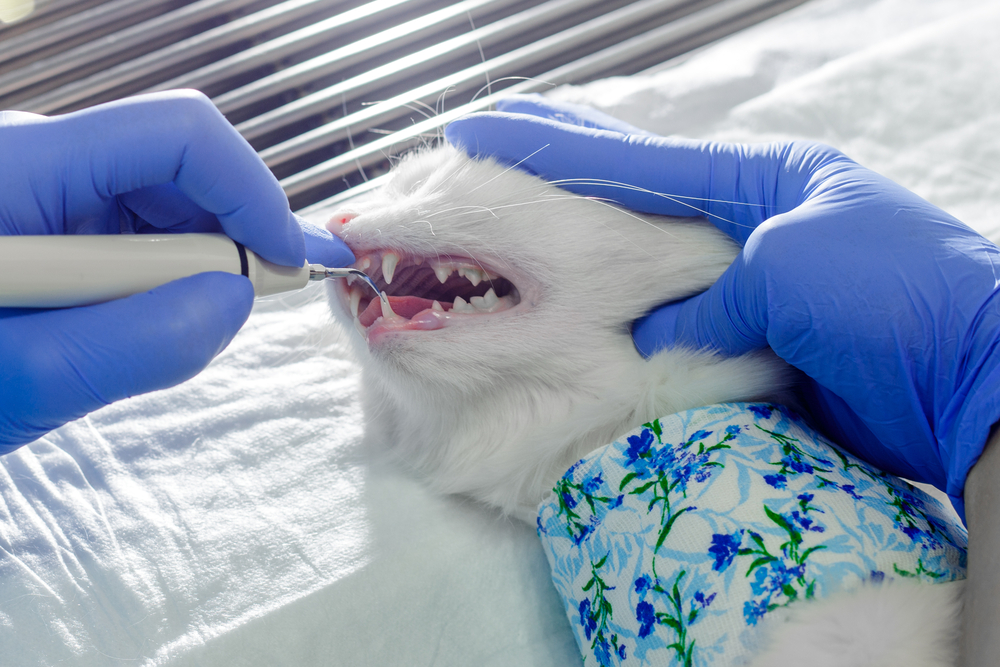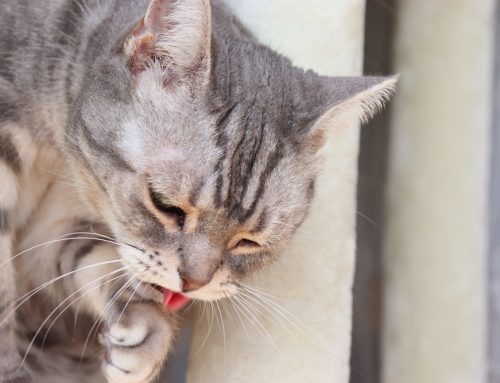Many factors affect a pet’s dental health, and the conditions can cause your pet significant pain, and possibly lead to serious health complications. Our Tidmore Veterinary Hospital team strives to promote a long, healthy, pain-free life for our patients, so we are providing information about common dental conditions in pets and explaining how you can protect your four-legged friend.
Periodontal disease in pets
Periodontal disease is the most common cause of unrecognized pain and infection in pets, affecting 80% of dogs and 70% of cats by 3 years of age. If your pet has stinky breath, they likely have some degree of periodontal disease, because the oral bacteria produce bad-smelling sulfur compounds. As infection progresses, the bacteria invade the oral tissues and under the gum line, damaging the teeth supporting structures, with potential consequences that include:
- Gingivitis — The initial stage of periodontal disease is gum infection that leads to swollen, bleeding, painful gums.
- Loose teeth — As periodontal disease advances, the tooth’s supporting structures deteriorate, leading to loose, painful teeth.
- Tooth root abscess — When the bacteria invade the sensitive tooth tissue, a painful tooth root abscess can form, causing your pet’s face to swell. In some cases, the abscess ruptures, which creates a draining tract from the face or jaw.
- Oronasal fistula — A fistula is an abnormal passageway, and an oronasal fistula is created when periodontal disease that affects an upper tooth creates an opening between the mouth and nasal passage. This allows food, saliva, and water to pass from the mouth into the nasal passage, causing irritation, and potentially leading to sinus infection.
- Eye infection — Your pet’s back, upper tooth roots are close to their eyes, and the inflammation and infection can invade the sensitive ocular tissue and lead to an eye infection.
- Jaw fracture — If bacteria invade the jaw bone, the bone weakens and the jaw may fracture. Cats and toy-breed dogs are at highest risk.
- Organ damage — Periodontal bacteria can enter your pet’s bloodstream and migrate through their body, damaging organs, such as the heart, kidneys, and liver.
Tooth resorption in pets
Tooth resorption is a progressive disease that leads to tooth destruction, and is seen commonly in cats, affecting about 75% of cats 5 years and older. While the disease is not as recognized in dogs, studies have demonstrated that as many as 53% of dogs show evidence of tooth resorption on X-rays. The cause is unknown, but theories include an autoimmune response, calicivirus, and metabolic imbalances related to calcium regulation. Tooth resorption lesions are typically not visible without X-rays, and the affected pet often exhibits no signs. Signs that are present may include jaw spasms, excessive drooling, oral bleeding, and difficulty eating. Treatment options include:
- Monitoring — If the lesion does not affect the tooth crown and causes your pet no pain or discomfort, we may recommend regular monitoring to determine when intervention is necessary.
- Extraction — In more advanced stages, the tooth must be extracted.
Oral cancer in pets
The most common oral cancers in dogs are melanoma, squamous cell carcinoma, and fibrosarcoma. Squamous cell carcinomas are by far the most common oral cancer in cats. Potential signs include excessive drooling, bleeding from the mouth, bad breath, weight loss, and difficulty chewing. A tissue biopsy is necessary to properly diagnose the oral lesion, and lymph node samples may also be needed to determine if the cancer has metastasized. Oral cancers in pets don’t typically respond well to chemotherapy, but other treatment options include:
- Surgical excision — Surgical removal is usually the treatment of choice for oral tumors, but the cancer may have spread.
- Radiation — Radiation is frequently recommended for tumors that can’t be completely surgically removed, or when metastasis occurs.
- Immunotherapy — Immunotherapy is available for some oral cancers.
- Preventing dental problems in pets
Not all dental conditions in pets can be prevented, but detection in the initial stages allows for early intervention to help prevent pain and serious health complications. Recommendations include:

- Regular wellness exams — Adult pets should be evaluated by a veterinary professional at least once a year, and senior pets, who are at higher disease risk, should be seen every six months. These visits help our team detect conditions such as periodontal disease and oral cancer in the early stages, when they are easier to treat.
- Professional veterinary dental cleanings — A professional veterinary dental cleaning is performed while your pet is anesthetized, so we can thoroughly evaluate their mouth without causing them stress. These procedures also involve dental X-rays, which allow us to detect conditions such as bone loss, jaw fractures, and tooth resorption lesions. Professional dental cleanings are the only way to effectively remove bacteria from under your pet’s gum line, where the most damage occurs. Most pets need the procedure once a year, but high-risk pets (i.e., senior pets, toy breeds, brachycephalic pets) may need more frequent evaluations.
- Toothbrushing — Daily toothbrushing removes plaque from your pet’s teeth between professional veterinary dental cleanings and can help prevent periodontal disease. In addition, the practice can help you detect abnormalities in your pet’s mouth that may need investigation.
Untreated dental conditions can cause pain and significant health complications for your pet. Contact our American Animal Hospital Association (AAHA)-accredited team at Tidmore Veterinary Hospital, so we can ensure your pet’s mouth is healthy and pain free.








Leave A Comment